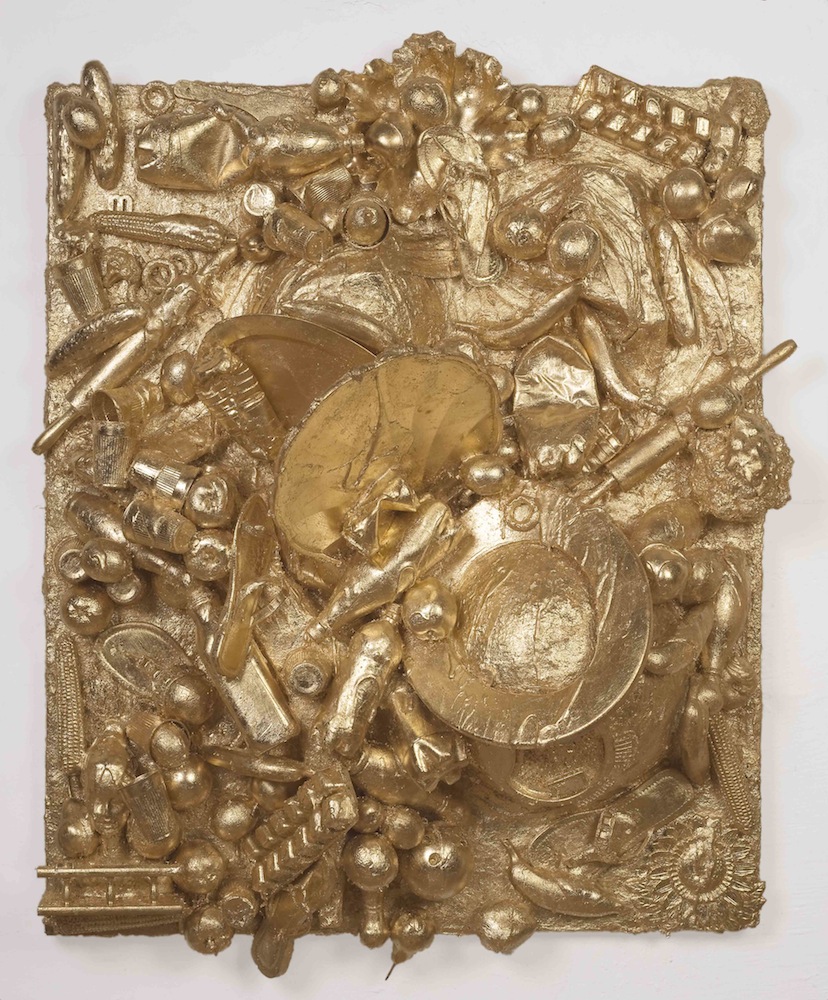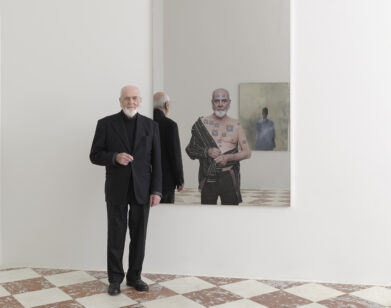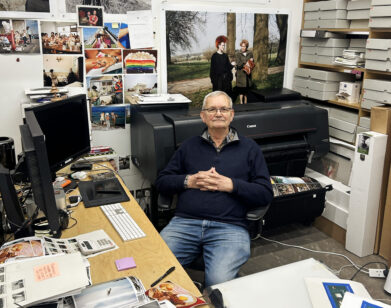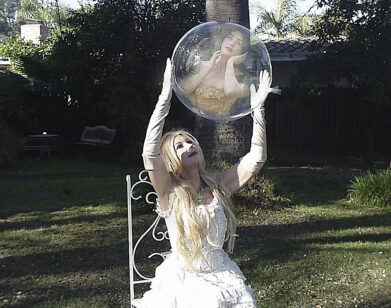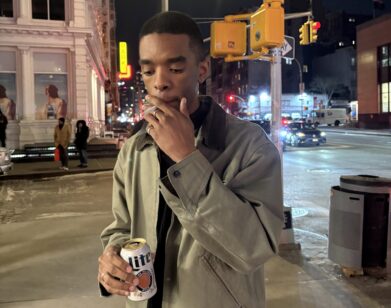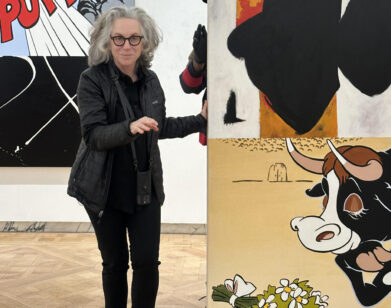John Miller Through Time and Space
Representing figures in various locales and from disparate demographics has been a thoroughfare of American artist John Miller’s practice since he began working in the 1970s. Through his sculptural, photographic, painted, and installed figurations, the conceptual artist continuously explores notions of identity, economics, and social class. Now on view at the Institute of Contemporary Art, Miami, the exhibition “John Miller: I Stand, I Fall,” curated by ICA Deputy Director and Chief Curator, as well as former Interview and Art in America online editor, Alex Gartenfeld, chronologically displays a wide range of Miller’s art, including never-before-seen works from the early ’80s and an ambitious mirrored labyrinth installed in the ICA’s atrium.
“Thematically, he’s focusing on figuration, ideas of what constitutes a figure, how I used the figure as a kind of rhetorical device, and how that differs from conventional realist or naturalist art,” Millers says of Gartenfeld’s approach.
At times, Miller’s work evokes similar notions to that of surrealism (i.e. questioning the truth and reality of everyday life and politics), albeit through more grounded imagery, like deadpan, realistic graphite drawings and photographs. His photographic series “The Middle of the Day” (1994-present) presents people in public spaces between the hours of 12pm and 2pm, the typical hours of a lunch break, resonating with the artist’s continuous and innovative exploration of economics and social class.
Though “I Stand, I Fall” is the Ohio-born, New York- and Berlin-based artist’s first comprehensive U.S. museum survey, he has previously exhibited around the world at institutions such as the Kunsthalle Zürich and Le Magasin in Grenoble. His work also stands in the permanent collections of the Whitney Museum of American Art, the Museum of Contemporary Art, Los Angeles, and Stedelijk Museum Amsterdam, among others.
Just before the opening of the exhibition, Miller spoke with longtime friend and fellow California Institute of the Arts graduate, the artist Christopher Williams.
CHRISTOPHER WILLIAMS: I have to warn you, I once was asked to do something for Interview that was supposed to be about five pages in print and we produced 75 pages of material.
JOHN MILLER: Better too much than too little. [both laugh]
WILLIAMS: So you’re in Florida?
MILLER: Yeah, I got here last night, just getting my bearings.
WILLIAMS: I thought I could start by asking you about your rules as an artist and the different activities you engage in as an artist. You’ve been working for a while and you’re putting together a retrospective. Could you say something about how different activities affect each other and how they’ve developed over the years?
MILLER: The three areas for me would be making work in the studio or outside of the studio, teaching, and writing criticism or texts that are works in themselves or straddling criticism. Those are the different spheres. I think they can reinforce each other but sometimes it’s a matter of what distinguishes them as the mode of reception or the context that people give them. Art & Language established, a long time ago, that a text can be an artwork, or even teaching younger people about art can be an artwork. It’s just a mode of reception and context that gives it a particular definition. Maybe that can even be equated to the way the art world sees photography, and the meaning of photographs being established by the channels they move through.
WILLIAMS: Do all of these things in your daily life overlap? Are you doing several things in the studio at once, or do you have time to set aside where you mostly write or mostly paint?
MILLER: During the school year there’s a lot of overlapping. During the summer—I’ve spent the last 26 years in Berlin during the summer—things are really quiet and it’s a little more concentrated. Another area that I left out was musical activities, just to make it more complicated, that’s another sphere. But one thing that seems inevitable is to what extent it becomes managerial versus doing the thing itself. It’s less the case in Europe, but in the U.S., with high tuition and an intensification of computer technologies, teaching has become more and more managerial—organizing classes, organizing forms of feedback for the students, and evaluating every step in the educational process. That can seem a bit burdensome.
In the studio, I’m in a phase where I’m pursuing a lot of stuff with assistants. Right now, I’m making these shaped pedestrian paintings. Put simply, they are paintings of pedestrians mostly standing on street corners waiting for the light to change. They’re from photos I shot myself, but I wanted a level of realistic painting that’s more objective than the way I usually paint. It’s taken a more technical approach to making these paintings, I have nine people who are painting things for me and they need to have panels ready when they’re ready to work. It puts more emphasis on the managerial side of things. I’m trying to sort out what that means; it allows me to make something more developed, whereas more of my early work, the facture of it was pretty simple. But I’m doing a few more simple, more direct things as well. I don’t know if you seen the PowerPoint works I’ve been doing?
WILLIAMS: I saw a couple. I’m not sure what they are, but you continue the “Middle of the Day” photographs, [a series of images taken in public spaces between 12 and 2pm].
MILLER: The PowerPoints are an outgrowth of those because I’ve reached a point with the “Middle of the Day” works where it’s both good and bad. The kind of photography I’ve done, starting in ’94, has become ubiquitous. On one hand I was posing my project as photos that anyone else could do, and now I see that everyone else is doing it in some manner. In ’94, I was trying to be inconspicuous by being on the street with a camera, but I stood out because I was this figure on the street with a camera and I was using it. Now, it’s hard to get a photograph without someone else with a camera being in the background. It isn’t necessarily a bad thing but it shows how the social position of photography has shifted radically since the mid-’90s.
WILLIAMS: Yeah, it’s incredible. I was trying to take a photograph in the canals in Venice and one of the things I saw right away was that everyone in the gondolas were taking pictures of themselves, rather than of Venice. So thousands and thousands of photographs go out, selfies from Venice, with very little of Venice, just Venice as a minimal framing device.
Another change I see with the “Middle of the Day” photographs is that you’ve gotten much better from the semi-skilled aspect of earlier ones. They’re becoming more competitive as street photos, in a way. I see the shaped pedestrian pieces as a way of recovering the directness and the awkwardness of earlier “Middle of the Day” photographs…
MILLER: I think that’s right on target. A lot of it has to do with technology. In the beginning I was using a more professional camera, a Mamiya, a medium format camera that you have to manually meter and set the exposure. Because of technical limitations, I might get, on a good day, three or four usable photographs. At the time I didn’t know it, but the choice of camera in some ways establishes a range of possible subject matter. That wasn’t evident to me when I started. Over time, I switched to a Nikon with auto-exposure and autofocus, and then I started with digital fairly early on. As a result, now, on a typical day, I can go out and shoot 300 exposures, so what I have to choose from is much broader. All of those things lead to a different quality of what the photograph is.
WILLIAMS: How many do you estimate there are now?
MILLER: That’s the thing with digital photography, what is and what isn’t the work? I have electronic archives and if I tallied up everything saved on a disk, that might be somewhere in the neighborhood of 5,000 to 6,000 images. I haven’t really counted them, even though I suppose it’s doable. It was a much more decisive thing when I was printing from negatives. I’d get a proof sheet, circle the ones I liked, and print them shortly after. Then I would have boxes of photographs and select some to show.
The digital files, many of them are potential works but in different stages. Some of them are optimized in Photoshop or Lightroom. Some of them I’ve just left as shots. Sometimes I go back and look at images and things will look interesting to me that I didn’t see upon first glance; I’d seen the photograph coupled with the blindness of producing the photograph.
WILLIAMS: Looking over the checklist for the exhibition, I was really happy to see there are so many graphite drawings of the dwellings, or real estate. I always really liked those because a vein of your work, which is curious to me, is that it’s so unaffected. It puts off so few contemporary art signals. Those drawings in particular are incredibly deadpan. They remind me of the kind of art you see in a dentist’s office and think, “I wish I could make something like that.” So unburdened by the appearance of intentionality and virtuosity.
MILLER: Someone once equated it to Hitler’s architectural studies. [laughs] But, you know, it’s fun. It’s something that runs back even to my first gallery show with Metro Pictures in ’84. I was interested in cultivating images that were pictures of pictures that would fulfill my fantasy where a man or woman on the street would think of it as an ordinary picture. I did these paintings that also had these qualities for my first show at Metro and it was interesting, the response I got.
Jean Fisher told me the only reason that the work had any credibility was because it was being shown at Metro Pictures and if you took away the context then the work would lose its value entirely, which I think was meant to be a negative criticism. But when you start thinking, isn’t that true of any art? Kim Gordon also saw the show and asked me if I had purchased all the paintings from a thrift store. Coming from her, that wasn’t meant as a jab; it was a sincere question and an approach that she thought would be valid. Later, Jim Shaw did do a whole thrift store painting show. At the time, I was thinking, “Of course not, don’t you see my subjectivity in the paintings?” I think the whole approach raises those issues.
Also, I think this was more the case in New York than L.A. in the 1980s, but there was a whole hegemony of the diptych that was coming very much out of David Salle‘s work. It seemed like it was offering viewers a false conundrum. I thought that montage strategy was working as a kind of avant-garde self-affirmation and I wanted to collapse pictorial conditions back onto themselves. Rather than providing the audience with a contradiction that would point to a nominal avant-garde status, I wanted there to be an absence of contradiction and a nothingness about the work that could easily validate it in visual terms, at least. And there, I think Jean Fisher’s comment about context is right on: If I had shown these paintings, say, in a vegetarian restaurant instead of Metro Pictures, their fate would’ve been much different.
WILLIAMS: I think that’s exactly where they gained their interest. A moment you and I share is sometime in the late ’70s, early ’80s, we both got involved with using something that looked like a normative or conventional display of art, but treating it as an installation or object against a backdrop, where works were very site-specific. The gallery was an extension of the canvas or a ground for painterly activity. We both saw the potential in overlooked conventions associated with very normative non-avant-garde art, let’s say.
MILLER: And an artist who uses the gallery space as a larger canvas, there’s almost an absence of rhetoric to that. Part of that, I think, relates to clear conventions of conceptual art, like the importance of the frame. You can easily go to the idea of a normative picture, to a frame, and go back and forth between those two things. What constitutes a worldview and what constitutes an ideology, I think those are probably the elements or the factors that led us to work that way.
WILLIAMS: I’m also thinking about your use of carpet and wallpaper recently that has to do with ideas about décor, staging, a more theatrical impulse, and maybe something related to the production of a different type of narrative.
MILLER: I’ve only done two carpets, but I did two fake game show sets. The first, I had an arena with a pile of dirt that had money and dildos strewn on it. When I showed that work both in Canada and France, the dildos were non-controversial. The money was the thing that got people up in arms. After that mound, I did a second game show set and replaced the mound with a flat carpet. I wanted to reduce the provocation to an absolute minimum. That’s the way carpets entered my work. Probably what took me into décor [is Claes] Oldenburg’s Bedroom Ensemble and the idea of a tension between an exhibition space and a domestic space.
WILLIAMS: I know you’ve talked about it before, but I really love the carpet piece with the potato.
MILLER: That was a work where I’d fill an entire room with wall-to-wall red carpet, cut out a shape slightly larger than the potato I’d selected, and have the potato resting on the floor beneath the carpet. I did it after we’d been living in Berlin for a while…Gerhard Schroder was the chancellor, and Schroder came to an event [in the courtyard] at Dan Graham’s café. They put this red carpet going from the street into the courtyard. At the entrance there are two rocks, and in order for the carpet runner to have a straight line, they cut a scallop out to accommodate the rock, which I thought was really childish—the idea that you can’t interrupt the vector of the carpet. My carpet piece was a version of that. In Germany there’s a term spießig, meaning fussy or uptight and a bit bourgeois. I think the origins of my carpet had to do with spießig.
WILLIAMS: You know, I don’t think of you as fussy. I know your work pretty well but I was surprised that that work was untitled. It also has an element I like, which is that you mobilize the tropes associated with surrealism without functioning as a surrealist. It’s a staging of surrealist or psychological imagery without being about personal subjectivity.
MILLER: Yeah, I guess it’s based on how you understand surrealism. For some artists, I think the Bretonian notion of surrealism is less important. For Mike Kelley, I think his favorite valance of surrealism was the William Burroughs variety. Mike introduced me to a lot of surrealist writing. It was through him that I discovered—maybe it’s an obvious discovery—that surrealism was more of a literary movement than an art movement. We Americans think of it as an art movement. For me, de Chirico is a really important figure, and one reason is that it’s so much about the transformation of public space. That was a direct inspiration for my “Middle of the Day” photographs and especially the piazza paintings. On one hand, the time of day those are done is indistinct, but you can also read them as representing the middle of the day during siesta time—the middle of the town is empty and on the peripheries there’s signs of industrialization and forces in conflict with the siesta, like factory towers smoking or a train. I once wrote a kind of artist’s text, and one of my claims was that de Chirico is not a metaphysical painter and thinking that’s a lazy way to see his work. I think he’s more of a historical painter.
WILLIAMS: Bringing up de Chirico, I thought of Man Ray when I was thinking about things to throw on the table. Is Man Ray somebody who you’ve spent time thinking about?
MILLER: I certainly like his work, but I haven’t thought about any works of his as precedents for what I do. I’d be curious to hear what you think…
WILLIAMS: There’s a painting called Regatta from 1924 of sailboats on a body of water, but it’s very crude. It’s painted with a pallet knife, and the sails, the boat, and the sun are painted black. I couldn’t help when I saw it but think of your painting Brown Sun, and the willful directness or clumsiness of it.
MILLER: There’s a sort of ritualized joke that I have with Bob Nickas, where sometimes I sing him a couple lines from “California Dreamin'” by The Mamas and the Papas, and I change the words to “All the leaves are brown / And the sky is brown.” [both laugh]
WILLIAMS: You know what, I am interested in humor but I don’t have any relationship to the joke form at all. I can’t retain jokes. Structurally I’m hardwired against being able to use them.
MILLER: I have a hard time telling conventional jokes, like if someone says, “Tell me a joke,” my mind goes blank. One of your rules is no humor.
WILLIAMS: Yeah, no plexiglass, no electricity, no humor. That being said, one of my favorite titles of yours is Haha Jerry Lewis and the painting of the dam.
MILLER: The painting of the dam you’re referring to comes from a series of Southwest landscape paintings, where I was trying to play with conventions of tourist painting but also trying to make the paintings as beautiful as possible. I wanted to index those to legitimize the art context, so to title those works I took phrases from reviews of my other work and used those as titles. I took little snippets from different writers. “Haha Jerry Lewis” was a review written by Marius Babias, who’s now director of N.B.K. in Berlin. He had written a favorable review about some of my work and wrote as an aside, “Haha Jerry Lewis.” As far as I know, no one’s traced phrases to reviews or mentioned much about that. It’s kind of a latent material in a way.
WILLIAMS: So [can you talk] about the selection of the works for this show? You’ve done a couple of surveys shows recently. For example, how does it relate to Zurich?
MILLER: That’s a good question because Alex Gartenfeld, who’s curating the show, was very much aware of both the show I had at the Kunsthalle Zurich and also, like 10 years before, the show I had at Le Magasin in Grenoble. He didn’t want to repeat either of those, so he made it a more labor-intensive show because he was looking for less well-known pieces, especially with early work. There’s a lot of early stuff we tried to track down that’s been dispersed for one reason or another, but he found a lot of early stuff and some that’s never been shown.
WILLIAMS: It’s interesting that he chose not to repeat those other shows. I would expect that an American audience hadn’t seen those shows. I also like that it addresses the idea that the identity of the work is not stable, that each show can reposition the work in a way that brings out different readings.
MILLER: Yeah, he’s very much into that. I think it’s just a generational difference, too. I know this from my students—they check out shows online all the time, they keep up with Contemporary Art Daily. So we might think, “Oh, this show was over there and this audience hasn’t seen it,” but younger artists, if they’re engaged, they’ve probably seen what’s available online. I always forget that because I’ve never gotten in the habit of looking at shows online. It’s just not something I do. But artists in their 20s and 30s are very much doing that.
WILLIAMS: I have to admit, I look at Contemporary Art Daily every morning. When I’m having coffee, I look at the New York Times and Contemporary Art Daily…
“JOHN MILLER” WILL BE ON VIEW AT THE ICA MIAMI THROUGH JUNE 12, 2016.

